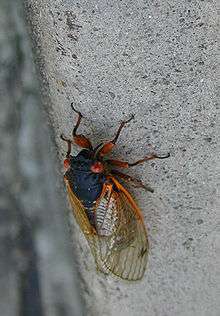Cicadomorpha
Cicadomorpha[1] is an infraorder of the insect order Hemiptera which contains the cicadas, leafhoppers, treehoppers, and spittlebugs. There are approximately 35,000 described species worldwide. Distributed worldwide, all members of this group are plant-feeders, and many produce either audible sounds or substrate vibrations as a form of communication. The earliest fossils of cicadomorphs first appear during the Late Permian.
| Cicadomorpha Temporal range: Upper Permian to Holocene | |
|---|---|
 | |
| A Magicicada species cicada | |
| Scientific classification | |
| Kingdom: | Animalia |
| Phylum: | Arthropoda |
| Class: | Insecta |
| Order: | Hemiptera |
| Suborder: | Auchenorrhyncha |
| Infraorder: | Cicadomorpha Evans, 1946 |
| Superfamilies | |
Classification
Some authors use the name Clypeorrhyncha as a replacement for the Cicadomorpha. Nymphs of many Cicadomorphans coat themselves with secretions from specialized Malphigian tubules. They are never coated with hydrophobic wax as seen in the nymphs of Fulgoromorpha. Most Cicadomorphas have a filter chamber in their mid-gut which helps remove excess water from the xylem or phloem sap that they feed on.[2]
Of the three extant superfamilies within the Cicadomorpha, molecular phylogeny studies have placed Membracoidea as a sister group to a clade containing Cicadoidea and Cercopoidea. Within these superfamilies, not all deep phylogeny questions have been resolved.[3]
References
- Evans JW (1946) A natural classification of leaf-hoppers (Jassoidea, Homoptera). Part 1. External morphology and systematic position. Transactions of the Royal Entomological Society of London 96 (3): 47–60.
- C. H. Dietrich in Resh, V. H. & Carde, R. T. (Eds.) 2003 Encyclopedia of Insects. Academic Press.
- Cryan, Jason R. (2005). "Molecular phylogeny of Cicadomorpha (Insecta: Hemiptera: Cicadoidea, Cercopoidea and Membracoidea): adding evidence to the controversy". Systematic Entomology. 30 (4): 563–574. doi:10.1111/j.1365-3113.2004.00285.x.